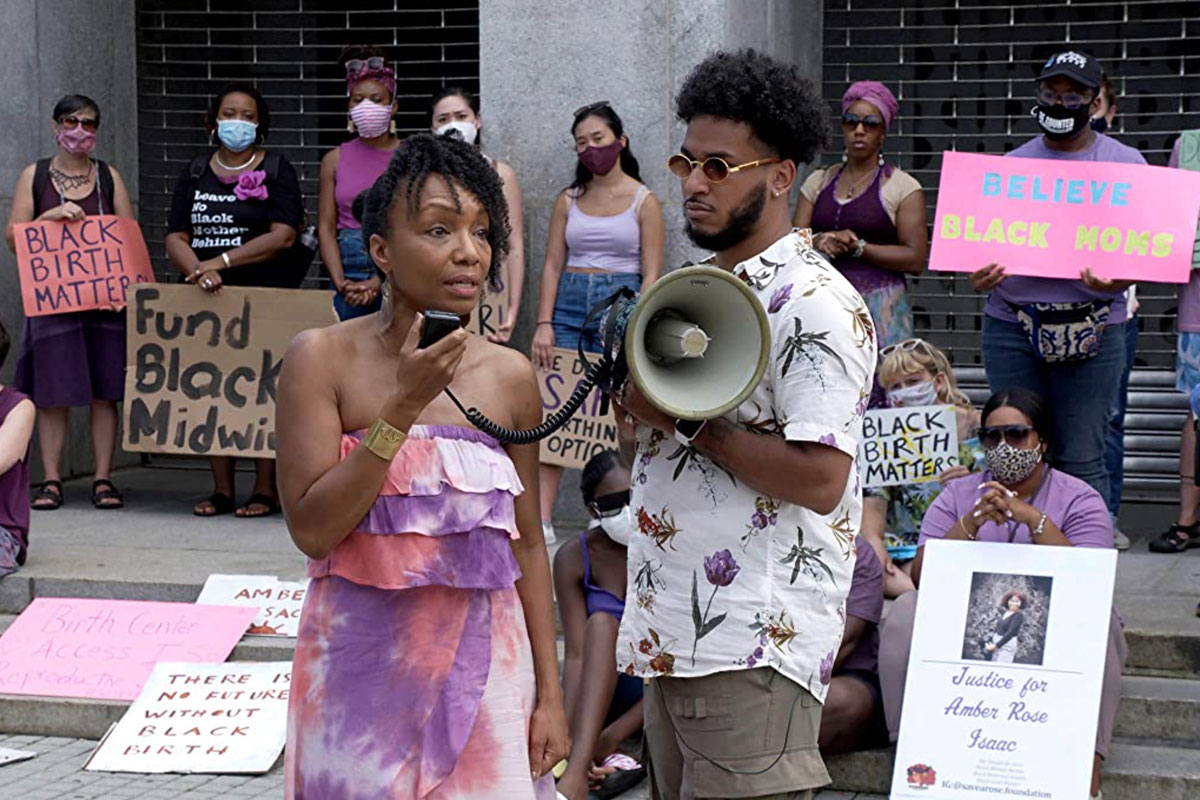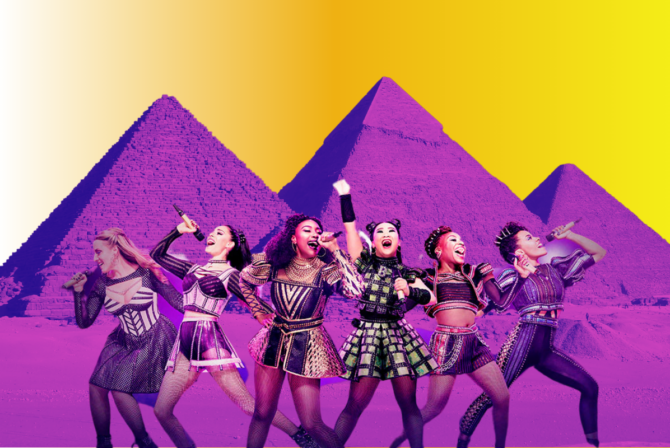Halfway through the documentary “Aftershock,” I was googling midwife programs. The film, which was co-directed by Jewish documentarian Paula Eiselt and Tonya Lewis Lee and will premiere at this year’s virtual Sundance Film Festival on January 23, paints the story of this country’s Black maternal health crisis in such stark colors that I felt like I wouldn’t make it through the 90-minute movie if I didn’t find some way to help. (As you’ll soon see, you don’t have to become a midwife to get involved.)
The film opens with the stories of two grieving Black New York families: Shawnee Benton Gibson is mourning the death of her daughter, Shamony Gibson, who died in 2019, 13 days after giving birth to her son. Shawnee, who painfully and ironically is a reproductive justice activist, pairs up with her daughter’s partner, Omari Maynard, a painter, as they try to turn their pain into action. Omari then reaches out to Bruce McIntyre, whose partner, Amber Rose Isaac, has just died after an emergency c-section — painfully and ironically at the same hospital where her mother used to work.
We follow these two bereaved families as they become activists and connect with others who have gone through the same thing. The film is heartbreaking, but it’s also a moving portrait of Black fatherhood, of families turning their grief into action and of how childbirth could look if real change happens.
In “Aftershock,” Dr. Neel Shah, a Harvard Medical School OBGYN professor, explains that the federal government only began systematically tracking maternal mortality rates in 2018, after journalists started writing about the disproportionate number of Black people dying during and after childbirth. He describes disturbing trends: The U.S. rate of cesarean sections, which are sometimes necessary but also a major surgery with attendant risks, has gone up 500% since the 1970s. The Black maternal mortality rate has doubled since the mid-1990s and is 3-4 times higher than it is for white women. There are many intersecting causes for these higher rates, including racism: Black patients are often taken less seriously by the medical establishment and have less access to quality medical care.
We see Dr. Shah teaching maternal health teams that communicating with their patients of color isn’t a treatment afterthought, but a treatment imperative; we see a Black couple in Tulsa, Oklahoma, a state with especially grim Black maternal mortality rates, have a successful and positive birth at a birthing center, surrounded by the support they need. We learn some of the history: Black enslaved midwives were pushed out of the profession in the mid-20th century as birth became increasingly medicalized; white doctors experimented on Black women as they tested new gynecological practices. The disturbing rates of Black maternal mortality have finally begun to get attention in the last few years both in the press and in Washington, where the House Committee on Oversight and Reform met on the Black maternal health crisis in May 2021.
The film is as galvanizing as it is devastating. Kveller spoke via Zoom to one of the directors, Paula Eiselt, a religious Jewish woman whose first documentary, “93Queen,” documented Hasidic women in Borough Park as they created the first all-female ambulance corps in NYC. (Full disclosure, I was so interested after watching “Aftershock” that I turned it into a double feature. “93Queen” does not disappoint.)
This interview has been lightly edited and condensed for clarity.
How did this film come to be? What drew you and co-director Tonya Lewis Lee to this story? (Tonya Lewis Lee is a director and producer who most recently worked on the Netflix series “She’s Gotta Have It,” created by her husband Spike Lee.)
I was drawn to the topic of maternal health in general because of my own pregnancies and births. I have four kids, thank God, and I’ve had my share of trauma birthing and carrying those children. So it was something that I was tuned into, but it wasn’t until the end of 2017 — I was actually still editing “93Queen” — that I started seeing slews of articles come out, mainly from ProPublica, about the US maternal health crisis. There’s a series called “Lost Mothers” and they did a great job going into that investigation. And when I read that, I realized that what happened to me in the system was happening to many women and was most especially and profoundly affecting Black women. I wanted to help lift up those stories and shed light on this crisis that is happening in the 21st century.
So from the get-go, I knew that I wanted to do this with a partner. For many reasons — the scope is huge; it’s a behemoth of a topic. And also I don’t have the lived experience of a Black woman, so I really did not want to make this film alone. I initially became a fellow at Concordia Studio and I pitched this project. I was able to secure development funding for the film and I started researching. I met Tonya at one of the first research shoots that I was doing, and one thing led to the next. We were a match in so many ways, and we came together as two women and two mothers. But a topic is not a film — it’s not a story. So it really was about finding our characters, our subject collaborators, to make this a film.
Tell me about that. How did you find these incredible families?
I had been delving into the birth justice world and community in my research. “Birth justice” is a term that was coined by Black women activists who have been working for birth justice, which is the intersection of reproductive justice and racial justice, for decades. This work has been happening. While the public is [now] becoming aware of the crisis, Black women have been leading this movement for decades. So I started researching the key players in the space and basically, one thing led to the next, and I saw that a woman named Shamony Gibson had passed away and that the family was putting on a memorial event, a celebration for her, very soon after she passed. I got in touch with Shawnee [Shamony’s mom], who’s the beating heart of this film, and immediately connected with her. Shawnee is our guiding light. Everything came from Shawnee. Then we got in touch with Omari and then Bruce. It was really this chain of events that started from Shawnee Benton Gibson.
What was it like co-directing with Tonya Lewis Lee?
It’s been really lovely. We came together with skill sets that were completely symbiotic and complementary. So we’ve done everything together — planning our shoots, everything. We’ve also leaned on each other in a lot of ways. So if there were shoots that I couldn’t be at — I keep Shabbat so I can’t film on Saturdays and that’s a challenge! — Tonya would fill in there. And when she was busy I filled in.
There are many factors contributing to higher levels of Black maternal deaths. Was it a challenge trying to touch on the many underlying causes? And why are birthing centers so important?
So there are a myriad of reasons for this crisis and also a myriad of solutions. The key is that there are solutions. This is not a hopeless crisis. This is something that we can, as a country and as human beings, do something about. That’s the spirit of the film. The racial disparities are a key driving factor of the maternal health crisis — the racism that is inherent in this system and that is designed as part of the system. It is a huge part of it. Black women who have PhDs are still five times more likely to die than white women with less than a high school education. So it’s not even a socioeconomic thing — it’s a real intersection of deep-seated racism and sexism within the system.
From a statistical point of view, in this country, birth is over-medicalized. We have an insanely high c-section rate and we don’t have midwives in our system. We have a completely different model than other Western countries in the world — many of them have midwives in their system. So the philosophy and care around birth is very, very different. It’s really too much too soon, too little too late. Everyone should have a safe, dignified birth wherever they birth. But we shouldn’t be intervening unless it’s necessary because a C-section is a major abdominal surgery. Birthing centers are common throughout the world. And the key is that when you have a birthing center, you’re given time, but you’re also in a medical facility.
Our system, the American system, is not an integrated system. In the UK, for instance, everything is integrated and supported by the country. So if you choose a home birth, that’s not stigmatized, you have the support you need to have that home birth, and there’s a system in place if you need to be transferred to a hospital. These are not alternative birth birthing plans. They’re part of a system where everyone works together. Here, no one’s talking to each other — doctors, midwives. There’s not a lot of integration.
There was so much history about midwifery that I didn’t know, like that white Americans relied heavily on Black enslaved midwives for centuries and then pushed Black midwives out of midwifery. That reminded me of some of the elements of your first feature, “93Queen,” about Jewish Haredi women who are getting involved in health care. One similarity is that both stories are about disenfranchising women in healthcare from within their own communities.
For me, there are a lot of throughlines. Both films deal with systemic failures that profoundly affect marginalized women within their own spaces. So they’re both looking at healthcare justice in different ways. In “93Queen,” a lot of the reasons Ezras Nashim [the all-female ambulance corps] was created was to help women, many of whom were giving birth and undergoing this really traumatic birthing experience where a group of men came into that space. As we see in “Aftershock,” having a dignified birth experience is not a luxury; it’s actually the foundation of safety and good outcomes. That was something that was a theme in both films — it’s not icing on the cake to have a nice experience. It’s actually life and death. When you’re not seen and not heard, people die that way.
Even though the stories in the film are deeply upsetting, the film also feels like a celebration of Black American life and a call to action to better support Black families. What are some ways that people can help?
I’m so glad to hear that you feel the empowerment and the solutions in the film because Tonya and I were very clear that while this is a heavy topic, it’s not doom and gloom. Our film collaborators and film subjects are working for change, and are making change, and it’s their power that is going to change things.
What people can do on a very direct level is support our subject collaborators. Shawnee and Omari have a foundation, the ARIAH foundation, that fundraises for maternal health through different initiatives. They have a postpartum week they’re putting on; they also do healing through arts because both Omari and Shawnee are artists.
Bruce has become such an incredible activist. Bruce is involved in the Bronx birthing community and is actually fundraising to build a birth center in the Bronx, the first ever — so that’s a really amazing, tangible initiative that people can get behind.
And then we can demand better care. There are the Momnibus Bills, a package of bills that are waiting to be passed that will directly help maternal health and especially Black maternal health. Tell your representative and your senator that you want these bills passed. They are sitting there! Lauren Underwood, Ayanna Presley, VP Kamala Harris and Cory Booker are sponsors. So there’s legislative action you can take, there’s direct action and supporting our subjects, and then there’s just being empowered. People need to be empowered in their birth and healthcare experience, to hold their healthcare buyers accountable, to demand from the system that things change. There’s a lot we can do!
“Aftershock” premieres online at the Sundance Film Festival on Sunday, January 23, 2022. You can find tickets here.








